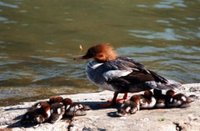Common Merganser
|
|
| Common Merganser Conservation status: Lower risk (lc) | ||||||||||||||
|---|---|---|---|---|---|---|---|---|---|---|---|---|---|---|
 Common Merganser | ||||||||||||||
| Scientific classification | ||||||||||||||
| ||||||||||||||
| Binomial name | ||||||||||||||
| Mergus merganser Linnaeus, 1758 |
The North American Common Merganser (Mergus merganser), or Goosander in Europe, is a large sea duck, which is distributed over Europe, North Asia and North America. Although belonging to the seaducks, they are most common on lakes and rivers. Their nests can be found in treeholes.
Males and females are easily distinguished, since the male merganser has a dark green head, while the head of the female is reddish-brown. The common merganser is 70 cm long.
These large fish-eaters have serrated edges to their bills to help them grip their prey. Along with the other typical mergansers, the Smew and the Hooded Merganser, they are therefore often known as "sawbills". They also eat mussels and shrimps; young birds mainly eat aquatic insects.
North American birds migrate south in small groups to the southern United States; on the west coast, some birds are permanent residents.
Scandinavian and Russian birds also migrate southwards, but western European birds are largely resident.bg:Голям нирец et:Jääkoskel lt:Didysis dančiasnapis nl:Grote zaagbek pl:Tracz nurogęś
